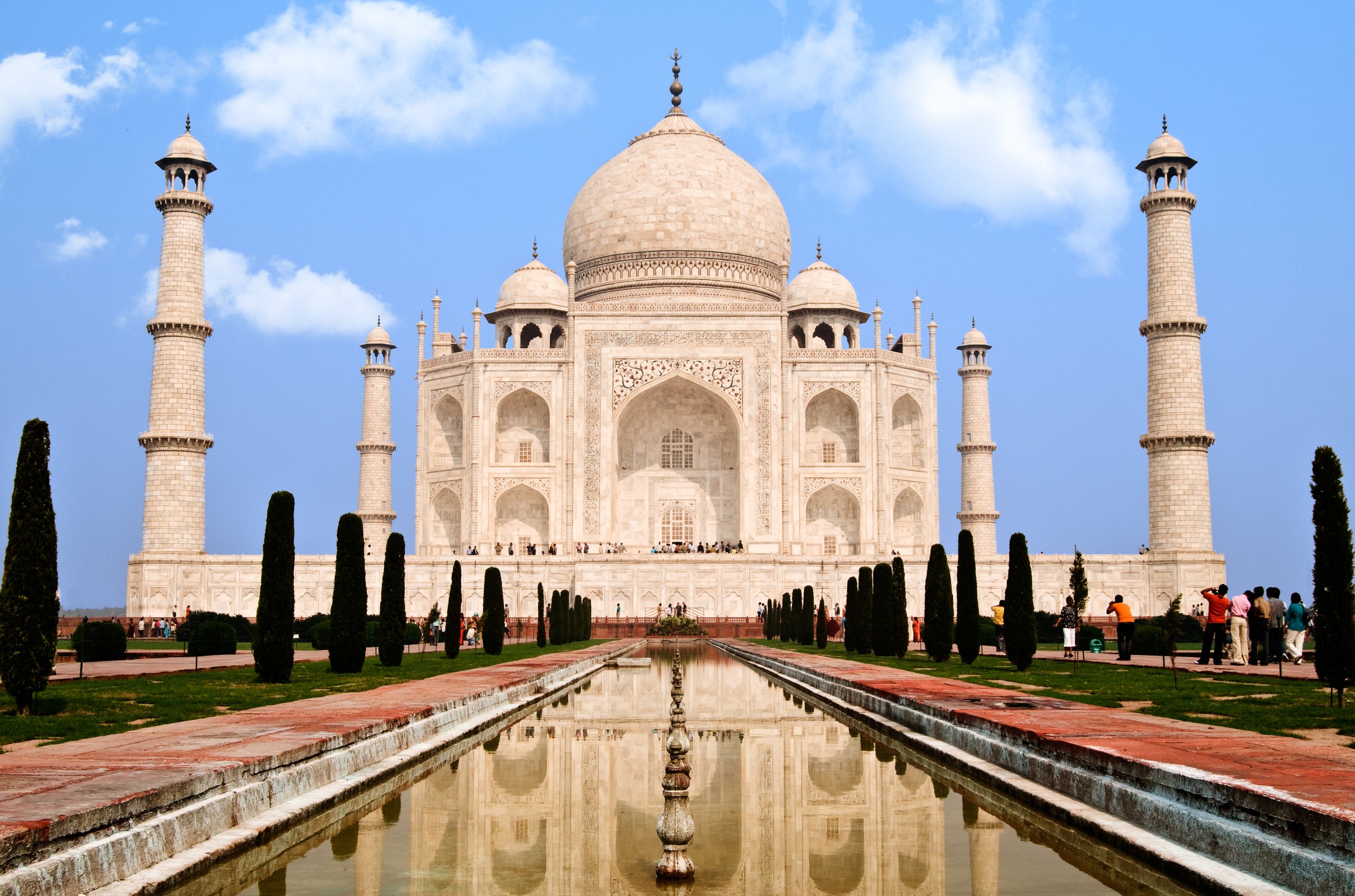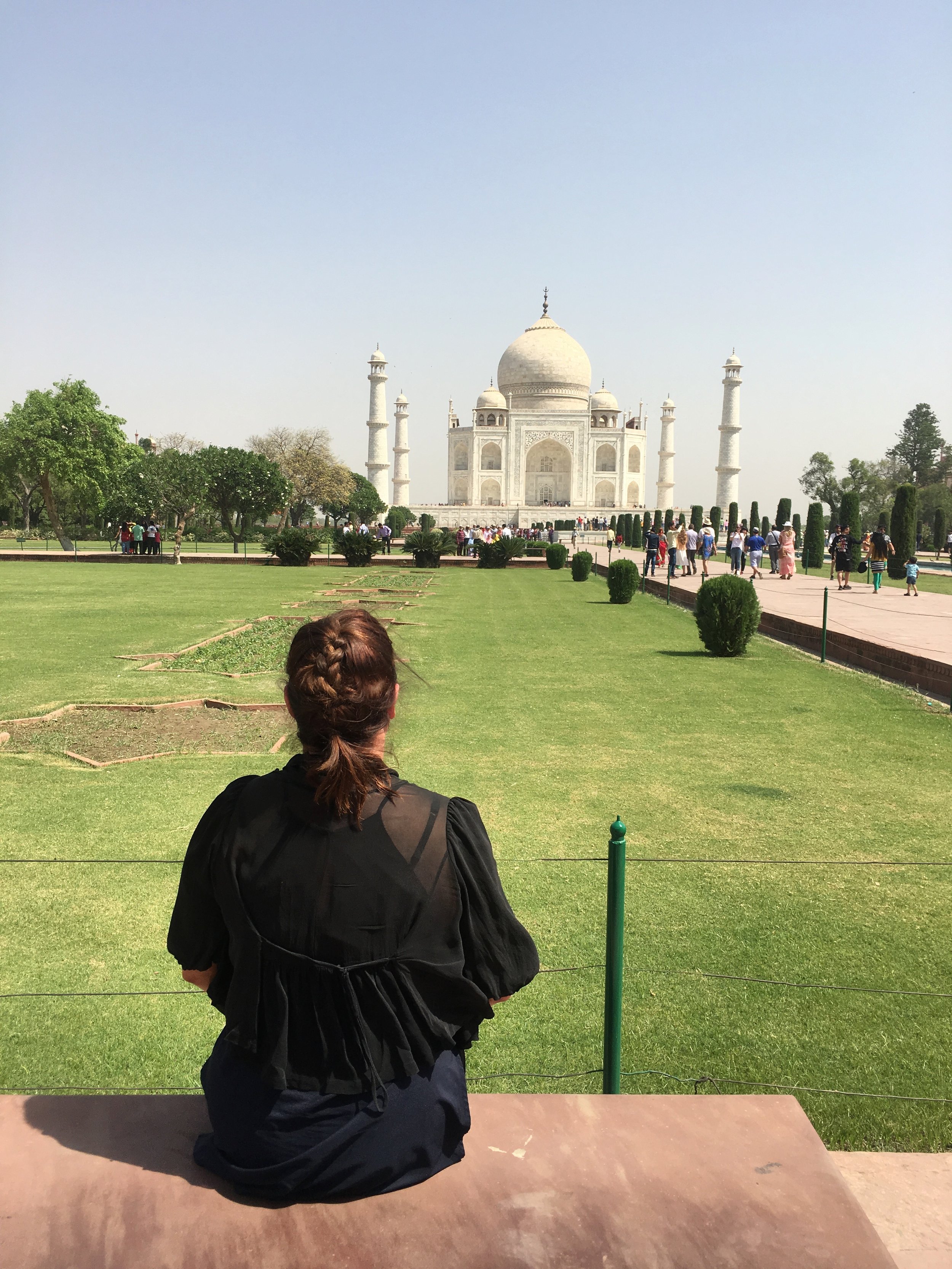Taj Mahal – A Jewel in the Art of India
Inspired by one of the greatest love stories ever told, the Taj Mahal was also the iconic backdrop to the collapse of one. Norah Casey sits on that bench and has her own spiritual moment at the most universally admired world heritage masterpieces.
On the right bank of the Yamuna river south of the walled city of Agra lies an immense mausoleum of white marble inspired by love and built to last. The Taj Mahal is magnificent to behold and mesmerising to gaze upon. The sunlight and shadows create hues of pink and white, stark against the vivid blue of the sky while shimmering in the reflective water below. This is without doubt one of the greatest architectural and artistic achievements in the world for its beauty and harmony.
Visiting the Taj Mahal was a real-life dream. But if I’m being honest, I’ve quite a few countries and world heritage sites under my belt and if anything, I am often underwhelmed. This however was the highlight of my visit to India. I was blown away.
The hype doesn’t do it justice because the real thing is spell bindingly monumental in scale and senses. There is a presence about the Taj Mahal, a sereneness which settles over you despite the crowds. The white gleaming façade is said to represent heaven on earth and the final resting place of the Mughal Emperor Shah Jahan’s beloved wife Mumtaz, a Persian Princess who died in childbirth.
And then there is what the guides call the ‘Lady Di Chair’. That iconic moment on the bench which captured her aloneness so graphically back in 1992. Speculation about her marriage difficulties were rife and Prince Charles had chosen to go elsewhere that day. That photograph made headline news across the world. It was just 10 months before her official separation from Prince Charles was announced. The image is printed in my memory. The poignant figure of Diana dressed in purple and orange sitting alone with the world’s most beautiful testament to love as a backdrop. The irony of her situation was not lost on the world.
Naturally the bench has attracted some famous visitors. Her son Prince William who along with Kate recreated that moment as a loving couple, Presidents Clinton, Putin, Obama and Trudeau, Oprah, Leonardo Di Caprio, Tom Cruise, Arnold Swartznegar and a multitude of other’s behinds have sat on that bench. And now mine too. It was quite something.
We booked a driver from Delhi for a day trip which is all the time I had. We left around 5am. Everyone tells you it’s a two-and-a-half-hour drive but the reality is more like four with lots of traffic delays, cows, monkeys, crashes, lane chaos and near misses to keep you wide awake for most of it. As we drove towards the walled city of Agra we stopped on the river bank dodging some early morning chaos caused by a nonchalant cow who bravely stood her ground against the blaring horn and simply stared into the distance chewing the cud. I admired her chutzpah but cows may be sacred in India but humans are not. So, I dived into a ditch to catch a glimpse of one of the most universally admired world heritage masterpieces in the distance through the early morning haze. An iconic outline so familiar from a lifetime of images.
But nothing is quite like being up close to the real thing. We picked up a local guide in Agra and although he said he had been a guide for 50 years and had probably told the story over 10,000 times he made it sound like it was the first. No mechanical vehicles are allowed near the Taj Mahal so we took a local rickshaw to the entrance. Prepare for queues and an airport-like security check system. Locals pay less to enter than you (which is only fair) and there are only a few items allowed to be taken in including camera, water, mobile phone and a small bag. The rest has to be placed in lockers. The entrance fee includes shoe covers which you need for entering the tomb.
Love Story
The first glimpse is magnificent. It took my breath away and despite the crowds rushing past me I remained transfixed at the sight. And here is the love story that led to the creation of the Taj Mahal. A grief-stricken Shah Jahan commissioned architect Ustad-Ahmad Lahori to start work on the Taj Mahal in 1631. His third wife Mumtaz had died giving birth to their 14th child and he wanted the grandest of designs for her final resting place. Their love story inspired the grand Persian and early Mughal architectural design and exquisite detail. It took 12 years to build, at a cost of over 50 billion Indian rupees. The main mausoleum was finished in 1643 and other buildings and the gardens about five years later. While many Mughal buildings were made with red sandstone, Shah Jahan wanted to use opulent gleaming white marble inlaid with semi-precious stones.
The most skilled artisans were recruited from across the empire, masons, stone-cutters, inlayers, carvers, painters, calligraphers and dome builders. Shah Jahan wanted nothing to ever rival the Taj Mahal and all of the artists signed an agreement in return for a hefty fee that they would not work on any other project in their lifetime. Some 28 precious and semi-precious stones from across Asia and India were inlaid into the translucent white marble from Makrana in Rajasthan. Over 1000 elephants and teams of twenty or thirty oxen hauled the materials along a 15-kilometre ramp, Lapis Lazuli from Afghanistan, turquoise from Tibet, sapphire from Sri Lanka, Carnelian from Arabia, Jade and Crystal from China, jasper from Punjab.
The most dramatic focus of the Taj Mahal is the white marble chamber framed by an archway and topped by the large 35-metre-high central dome where they both are now laid to rest (although you are able to visit features replica sarcophagi of Shah Jahan and Mumtaz they are actually buried lowered down, with their faces turned right towards Mecca). The ninety-nine names of God are inscribed on the sides of her actual tomb. The lotus motif features throughout the design, on top of the main dome, the smaller domes (chattris) and the decorative spires. The minarets stand 40 metres tall and provide the perfect symmetry of the UNESCO World Heritage site. Twice the domes and minarets had to be hidden by scaffolding during wartime to escape bombing.
Viewing from a distance is incredible but as you get up close and wander through the chambers and grounds you see the beautiful calligraphy and motifs with passages from the Qur’an decorating the walls. Delicate herringbone inlays create subtle artwork while dark and black inlays against the white marble add drama and texture. The more you wander around this fascinating building the more you see. Delicate marble lattice work separates the glaring sun from the shadowed interior where flowers and vines come to life over frames and archways with polished inlaid stones of yellow marble and jade.
The Persian inspired gardens are said to represent the four flowing rivers of Paradise, with heavenly fountains and avenues of trees the prelude to the main magnificent spectacle. On the other side of the Yamuna river lies the Moonlight Garden to the back of the Taj Mahal and the only side not bordered by sandstone walls. To add balance two grand sandstone buildings which mirror each other (a mosque and Jawab) stand in contrast to the white gleaming marble of the Taj. The mosque floors feature the outlines of 569 prayer rugs in black marble.
Since that ‘Diana moment’ tourism has increased ten-fold and with 8 million visitors annually the government has recently announced limitations on visitor time at the Taj. Currently it opens at 6am and is open each day except Friday. Like many world-famous sites, pollution and tourism are taking its toll, this is one place you should see before you leave this earth. For a prelude of heaven or a spiritual moment like no other, don’t delay








